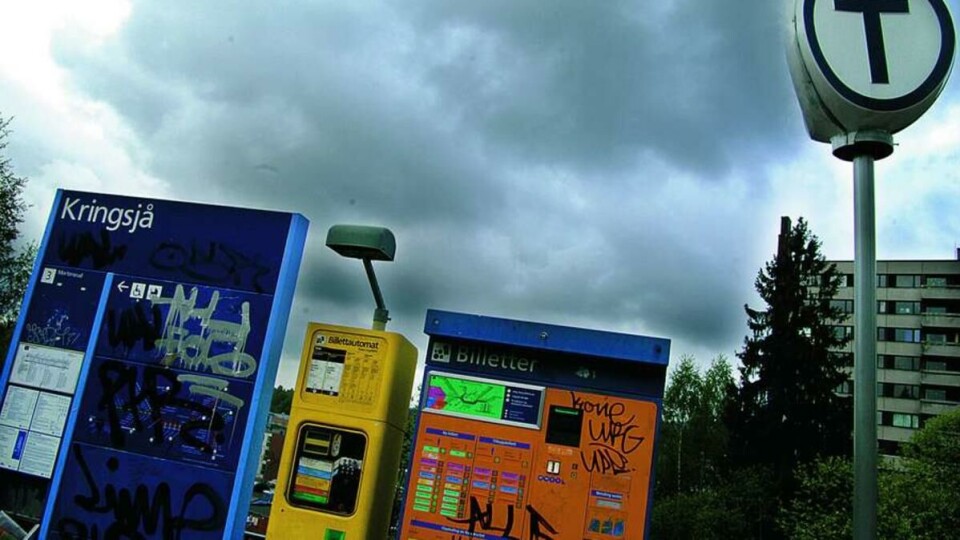
Kringsjå Student City
Kringsjå's the one student housing complex people just can't seem to agree about.

Subway train 3 inches towards the second to last stop on the road to Sognsvann and the Norwegian School of Sport Sciences. People flock in and out of the cars, on their way either to or away from the paved ocean of glass, brick and concrete that has settled between the subway stop and the Nordmarka forest. Box-shaped buildings, just as colourless no matter from which side you choose to look at them, occupy a lot of the field of vision. Smack-dab in the middle of the picture, as if somebody dropped them straight from the leaden sky, two highrises struggle to break the monotony. This the Kringsjå and Fjellbirkeland student housing complex, and this is where more than half (57 percent, to be precise) of all foreign exchange students at the University of Oslo stay.
With a total of 31 buildings and some 2005 housing units, Kringsjå and Fjellbirkeland is the Student Life Association's largest housing complex. At the same time, this is Oslo's largest concentration of foreign exchange students. Students from more than a hundred different nations sleep, study and form friendships here, they shop at Kiwi, pick up their mail, use the excercise room, the wash room and other common rooms, all for a price ranging from 2000 to 3328 kroner.
Wasted integration?
From a small balcony on the ninth and top floor of building 10, one of the two highrises, Australian Inia Nicholls (26) gazes out at the student city. Nicholls is vice president of The International Student Union of Oslo, and he's a bit tired of the image of Kringsjå as a concentration of foreign students; the idea that Kringsjå is a ghetto. According to Nicholls, foreign students wouldn't necessarily benefit that much from being scattered all across Oslo.
– Foreign students have exactly the same goals and ambitions for their studies that Norwegian students have. They want to have a good time, meet new people, make new friends. And like it or not, these wishes come true more easily when you spend a lot of time with people in the same situation. Like up here.
When Universitas discusses the issue with ISU president and Nicholls' superior Ricardo Duque, he puts forth a different view. Duque, who also is active as a member of the Oslo Student Parliament political group Moderat Gruppe, a center-right group, is of the opinion that so many foreign students being mashed together in a small area of the city is a problem.
– A limited number of places for international students to stay, means that these students have fewer opportunities to participate in Norwegian society. A too high concentration of foreign students in one or two student housing complexes leads to excluding behavoir patterns, because you feel more comfortable in the company of people in the same situation as yourself.
– But does this mean that one ought to force students to get integrated?
– Even though it serves no purpose to force people into integration, it is still prudent to create as multicultural an environment as possible, with as many Norwegian impulses in it as possible.
Cheap, but far off
Most Kringsjå-dwellers ended up here because it's cheap. When you go to one of the world's most expensive countries to study, rental prices are a major hurdle. Students know this, and the Student Life Association knows. The University of Oslo has to vouch for foreign students' down payments on their dorm rooms, and as Kringsjå and Sogn are the student housing complexes with the lowest down payments, they are the choice locations.
Duque does not think this arrangement is satisfactory.
– Both the Student Parliament and the ISU believe that if the government was willing to finance more of the other student housing complexes in Oslo, their prices would drop towards Kringsjå and Sogn levels. In turn, this would enable the University International Office to offer rooms at other complexes to foreign students, and would counteract the ghettofication tendencies at Kringsjå and Sogn.
To German Jarina Gerig (24), American Jesse Teilmann (22), and Canadians Jessica Choi (21) and Shane Warren (26), these things are less important. They're happy living at Kringsjå, and don't really find much to complain about, except from the fact that Kringsjå is too far away from downtown Oslo.
– It's impossible to get home from Stargate, Jessica says.
– Unless you take a cab, and then you're broke until way into next semester.
They've all attended Norwegian class, with mixed results.
– It's hard to learn the language, and because of that, it's hard to get a job, Shanse says.
In general, Shane ends up speaking English with everybody, including Norwegian studetns.
– Communicating with Norwegian is like turning off a switch. As soon as I try a little Norwegian, they don't understand a thing and just stare at each other in horror. And since they like speaking English anyway, it's easiest for everyone if I just keep doing that.
Melting pot
To Nicholls, communication problems aren't a phenomenon exclusively reserved for relations between Norwegian and foreign students.
– You must remember that the international group isn't a single homogenous group. It consists of several subgroups who never meet. At Kringsjå, for instance, there are Asian and African communities that us students from western nations don't have any contact with at all.
Nicholls believes the most important reason for this is different approaches to social drinking.
– People I met during the introduction week, and who I talked a bit with back then, just dropped out after a while, simply because they lack the habit of going out every night to drink huge amounts of alcohol. Our way of socializing is completely alien to them, so they find alternative ways of doing things. In the end, we don't have any common points of reference any more. Instead, cliques and subgroups form.
ISU president Duque doesn't live at Kringsjå, and is pleased with that. He likes not having to live at a construction site during the start of the semester.
– For the time being, the construction work makes conditions at Kringsjå intolerable. However, except for its location, Kringsjå isn't a bad place to live. But overpopulated kitchens, sloppy cleaning and tendencies to stay inside or only know a limited number of people sometimes tend to make Kringsjå a less pleasant place.
His vice president, Nicholls, recently found a new place to live, and has left his twelve square meters behind. Still, he visits Kringsjå every now and then, to see friends and relax.
– When you look at it, it's not especially beautiful here, Nicholls says, and stares down at the buildings belove.
– Architectonically speaking, Kringsjå is a dump. A hole in the road. During the week, this place is completely dead.
But still:
– On Thursday, Friday and Saturday, this place can be fucking Disneyland.
































